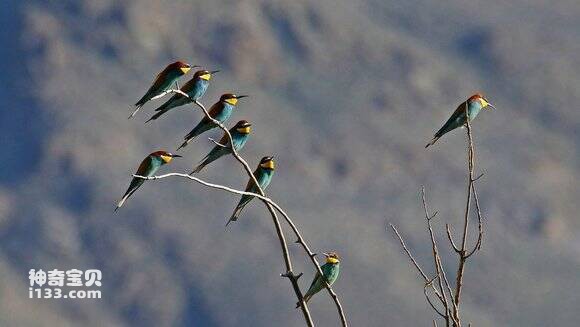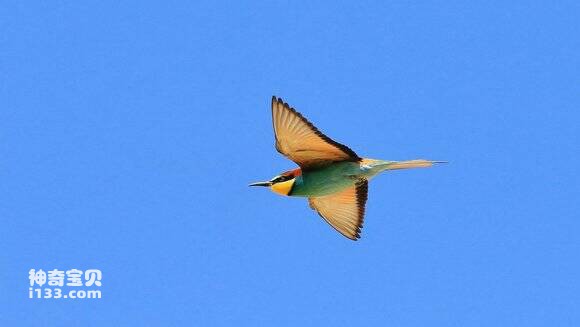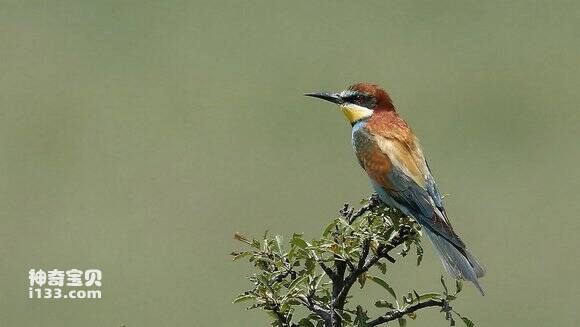Merops apiaster
IUCN
LCBasic Information
Scientific classification
- name:Merops apiaster
- Scientific Name:Merops apiaster,European Bee-eater
- Outline:Climbing birds
- Family:
Vital signs
- length:23-30cm
- Weight:50-60g
- lifetime:No textual research information is available
Feature
The bright yellow plumage of the throat is its main feature
Distribution and Habitat
It is distributed in Afghanistan, Albania, Algeria and Angola , Armenia, Austria, Azerbaijan, Bahrain, Belarus, Belgium, Benin, Bosnia and Herzegovina, Botswana, Bulgaria, Burkina Faso, Burundi, Cameroon, Central African Republic, Chad, China, Democratic Republic of the Congo, Cote d 'Ivoire, Croatia, Cyprus, Czech Republic, Denmark, Djibouti, Egypt, Eritrea Asia, Ethiopia, Finland, France, Gabon, Gambia, Georgia, Germany, Ghana, Gibraltar, Greece, Guinea, Guinea-Bissau, Hungary, India, Iran (Islamic Republic of), Iraq, Israel, Italy, Jordan, Kazakhstan, Kenya, Kuwait, Kyrgyzstan, Latvia, Lebanon, Lesotho, Liberia, Libya, Macedonia, Malawi, Mali, Mauritania, Moldova, Montenegro, Morocco, Mozambique, Namibia, Netherlands, Nigeria, Oman, Pakistan, Palestine, Poland, Portugal, Qatar, Romania, Rwanda, Saudi Arabia, Senegal, Serbia, Sierra Leone, Slovakia, Slovenia, Somalia, South Africa, South Sudan, Spain, Sri Lanka, Sudan, Eswatini, Sweden, Switzerland, Syrian Arab Republic, Tajikis
Appearance
The forehead of the yellow-throated bee tiger is white to blue and green, and meets with a fine brow line; The top of the head is chestnut, and the shoulders are yellowish brown. Yellowish-chestnut below lower back; The waist is green; Tail blue-green, with narrow black-brown to black pinnacles. Small wing cover green, medium and large cover chestnut; Primary cover and flange light blue-green; Primary feather base green gradually blue, to end black; Lateral secondary feathers chestnut with black tip; The inner secondary feathers are blue-green, but the underside of the inner feathers is pale maroon. The eyes and overlying ear feathers are black, while the cheeks, chin and throat are yellow, and the underside is surrounded by a black half ring; The rest of the lower body is light greenish-blue, the chest color is the most dense and deep, and the anal and tail coverts are the most thin and light. Underwing coverts and axils light yellow.
Young rarely chestnut on head and nape; The win
Details
The yellow-throated Bee-eater is Merops apiaster, or European bee-Eater, with no subspecies.
Yellow-throated bee-eaters summer migrants. Spring moves in in April and autumn moves out in September-October. Often move in groups. Most of the day is spent in the air, flying straight and fast, with rapid flapping of the wings, sometimes accompanied by gliding. Not afraid of people, sometimes into the cottage, house behind the house and orchard activities, rest on the wire, dead branches or shrubs. Hunting on the fly.

Yellow-throated bee-eaters feed mainly on a variety of insects. The food varies by place and season. In addition to bees, it also preys on insects such as weenworms, ulmus moths, flies, dragonflies, termites, butterflies and other lepidoptera, as well as crustaceans. Often live on branches or wires and other places to wait, once the flying insects approach, fly and peck. They hunt in the air. They hunt as they fly.

The breeding season is from May to July. They often breed in groups ranging in size from a few pairs to nearly a hundred, rarely breeding in single pairs. They usually nest on high and steep river banks, hanging rocks and gullies. The nest is tunneled, and the male and female birds take turns digging it with their mouths and digging the soil back with their feet. Nest holes are generally about 0.5-1.5 meters long, sometimes up to 2 meters long. The diameter of the hole is 8-10 cm, and the end of the nest hole is enlarged, which is the nesting chamber with a diameter of 15-20 cm and a height of 12-15 cm. Each nest hole takes about 10-20 days to complete. The eggs are laid directly on the ground inside the nest without any internal bedding. They breed 1 litter every year, laying 4-8 eggs per litter, occasionally up to 9 and 10, usually 5-6. Oval white, 24-29 mm x 20-23 mm in size. Male and female birds incubate the eggs in turn, mainly female birds, and the incubation period is about 20 days. Young birds are late sex, and male and female birds raise young together.

Listed on the International Union for Conservation of Nature (IUCN) 2012 Red List of Threatened Species ver 3.1 - Not Threatened (LC).
Protect wild animals and eliminate wild meat.
Maintaining ecological balance is everyone's responsibility!









